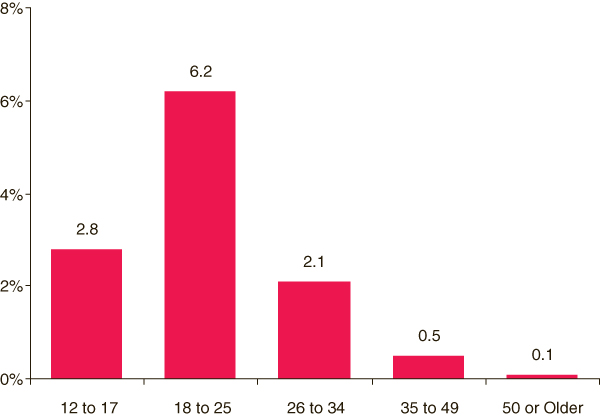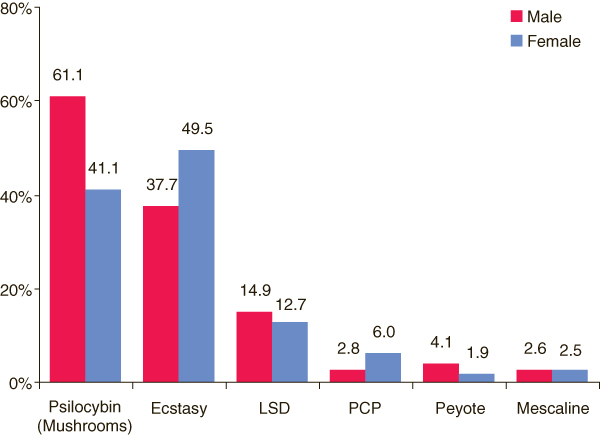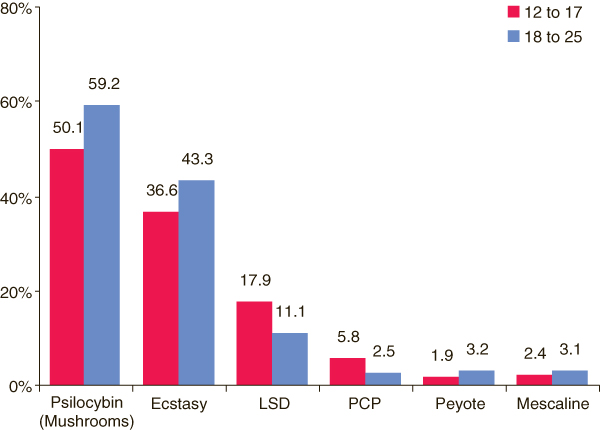 |
| July 5, 2007 |
Patterns of Hallucinogen Use and Initiation: 2004 and 2005
In Brief
- Combined data from 2004 and 2005 indicate that an annual average of 943,000 persons aged 12 or older used hallucinogens for the first time in the 12 months before the survey (i.e., they were recent initiates)
- Combined data also indicate that 52.3 percent of recent hallucinogen initiates used psilocybin mushrooms and 42.9 percent used Ecstasy in the past year
- Recent female initiates were more likely than their male counterparts to have used Ecstasy (49.5 vs. 37.7 percent), while recent male initiates were more likely than their female counterparts to have used psilocybin (61.1 vs. 41.1 percent)
|
Hallucinogens, such as lysergic acid diethylamide (LSD) and phencyclidine (PCP), are strong, mind-altering drugs that cause hallucinations and produce rapid, intense mood swings.1 Many indicators of hallucinogen use have shown decreases in the past several years,2-4 and the number of admissions to treatment in which hallucinogens were reported as the primary substance of abuse decreased from 3,040 in 1995 to 2,057 in 2005.5
The National Survey on Drug Use and Health (NSDUH) asks persons aged 12 or older questions related to their use of hallucinogens in the past year. Hallucinogens specified in NSDUH include LSD, PCP, MDMA (Ecstasy), peyote, mescaline, and psilocybin found in mushrooms. Respondents who used these substances are asked when they first used them; responses to these questions were used to identify persons who had initiated use in the 12 months before the survey.6 This report examines patterns in the use of hallucinogens among persons aged 12 or older. All findings are annual averages based on combined 2004 and 2005 NSDUH data.
Past Year Hallucinogen Use
Combined data from 2004 and 2005 indicate that an annual average of 1.6 percent of persons aged 12 or older (an estimated 3.8 million persons) used hallucinogens in the past year. Males were about twice as likely to have used hallucinogens in the past year as females (2.1 vs. 1.1 percent). Young adults aged 18 to 25 had higher rates of past year hallucinogen use than those in other age groups (Figure 1).
Figure 1. Percentages of Past Year Hallucinogen Use among Persons Aged 12 or Older, by Age Group: 2004 and 2005
 |
Figure 1 Table. Percentages of Past Year Hallucinogen Use among Persons Aged 12 or Older, by Age Group: 2004 and 2005
| Age Group |
Percent |
| 12 to 17 |
2.8% |
| 18 to 25 |
6.2% |
| 26 to 34 |
2.1% |
| 35 to 49 |
0.5% |
| 50 or Older |
0.1% |
| Source: SAMHSA, 2004 and 2005 NSDUHs. |
Past Year Initiation of Hallucinogen Use
Combined data from 2004 and 2005 indicate that an annual average of 943,000 persons aged 12 or older used hallucinogens for the first time (i.e., were recent initiates) in the 12 months before the survey. This represents 0.5 percent of those at risk for initiation (i.e., those who had not previously used hallucinogens). Among those at risk for initiation of hallucinogen use, the rate of recent initiation was somewhat higher among males than females (0.5 vs. 0.4 percent). The rate of recent initiation of hallucinogen use was 1.7 percent among both youths aged 12 to 17 and young adults aged 18 to 25, and 0.1 percent among adults aged 26 or older.
Initiation of Specific Types of Hallucinogens
Combined data from 2004 and 2005 indicate that 52.3 percent of recent hallucinogen initiates used psilocybin mushrooms and 42.9 percent used Ecstasy in the past year. Fewer recent initiates used LSD (13.9 percent), PCP (4.2 percent), peyote (3.1 percent), or mescaline (2.5 percent). Males and females differed in the types of hallucinogens they used (Figure 2). Recent male initiates were more likely than their female counterparts to have used psilocybin mushrooms (61.1 vs. 41.1 percent). Recent female initiates were more likely than their male counterparts to have used Ecstasy (49.5 vs. 37.7 percent) and PCP (6.0 vs. 2.8 percent).
Figure 2. Percentages of Past Year Use of Specific Types of Hallucinogens among Recent Hallucinogen Initiates* Aged 12 or Older, by Gender: 2004 and 2005
 |
Figure 2 Table. Percentages of Past Year Use of Specific Types of Hallucinogens among Recent Hallucinogen Initiates* Aged 12 or Older, by Gender: 2004 and 2005
| Types of Hallucinogens |
Male |
Female |
| Psilocybin (Mushrooms) |
61.1% |
41.1% |
| Ecstasy |
37.7% |
49.5% |
| LSD |
14.9% |
12.7% |
| PCP |
2.8% |
6.0% |
| Peyote |
4.1% |
1.9% |
| Mescaline |
2.6% |
2.5% |
| Source: SAMHSA, 2004 and 2005 NSDUHs. |
In addition, there were differences in the types of hallucinogens used by persons in different age groups (Figure 3). Recent initiates aged 12 to 17 were more likely than their 18- to 25-year-old counterparts to have used LSD (17.9 vs. 11.1 percent) and PCP (5.8 vs. 2.5 percent), while recent initiates aged 18 to 25 were more likely than their 12- to 17-year-old counterparts to have used psilocybin (59.2 vs. 50.1 percent) and Ecstasy (43.3 vs. 36.6 percent).
Figure 3. Percentages of Past Year Use of Specific Types of Hallucinogens among Recent Hallucinogen Initiates* Aged 12 or Older, by Age Group**: 2004 and 2005
 |
Figure 3 Table. Percentages of Past Year Use of Specific Types of Hallucinogens among Recent Hallucinogen Initiates* Aged 12 or Older, by Age Group**: 2004 and 2005
| Types of Hallucinogens |
12 to 17 |
18 to 25 |
| Psilocybin (Mushrooms) |
50.1% |
59.2% |
| Ecstasy |
36.6% |
43.3% |
| LSD |
17.9% |
11.1% |
| PCP |
5.8% |
2.5% |
| Peyote |
1.9% |
3.2% |
| Mescaline |
2.4% |
3.1% |
| Source: SAMHSA, 2004 and 2005 NSDUHs. |
End Notes
1 National Institute on Drug Abuse. (2001). Hallucinogens and dissociative drugs, including LSD, PCP, ketamine, dextromethorphan (DHHS Publication No. 01-4209). Rockville, MD: U.S. Department of Health and Human Services, National Institutes of Health. [Available at http://www.drugabuse.gov/ResearchReports/hallucinogens/hallucinogens.html]
2 Office of Applied Studies. (2006). Results from the 2005 National Survey on Drug Use and Health: National findings (DHHS Publication No. SMA 06-4194, NSDUH Series H-30). Rockville, MD: Substance Abuse and Mental Health Services Administration.
3 National Institute on Drug Abuse. (2006, June [printed November 2006]). Community Epidemiology Work Group: Epidemiologic trends in drug abuse advance report (NIH Publication No. 06-5878A). Bethesda, MD: U.S. Department of Health and Human Services, National Institutes of Health. [Available as a PDF at http://www.drugabuse.gov/about/organization/cewg/Reports.html]
4 National Drug Intelligence Center. (2006, January). National Drug Threat Assessment 2006 (Report No. 2006-Q0317-001). Johnstown, PA: Author. [Available at http://www.usdoj.gov/ndic/pubs11/18862/index.htm]
5 Office of Applied Studies. (2006, November [posted to Web in February 2007]). Treatment Episode Data Set (TEDS) highlights – 2005: National admissions to substance abuse treatment services (DHHS Publication No. SMA 07-4229, Drug and Alcohol Services Information System Series S-36). Rockville, MD: Substance Abuse and Mental Health Services Administration. [Available at http://www.oas.samhsa.gov/dasis.htm#teds3]
6 Respondents whose age at first use was equal to or greater than 1 year less than their current age were asked to indicate the year and month in which they initiated use.
Figure Notes
* Recent initiates are defined as persons who used hallucinogens for the first time in the 12 months prior to the survey.
** Estimates for persons aged 26 or older are not displayed because of low precision.
Suggested Citation
Substance Abuse and Mental Health Services Administration, Office of Applied Studies. (July 5, 2007). The NSDUH Report: Patterns of Hallucinogen Use and Initiation: 2004 and 2005. Rockville, MD.
The National Survey on Drug Use and Health (NSDUH) is an annual survey sponsored by the Substance Abuse and Mental Health Services Administration (SAMHSA). Prior to 2002, this survey was called the National Household Survey on Drug Abuse (NHSDA). The 2004 and 2005 data used in this report are based on information obtained from 136,068 persons aged 12 or older. The survey collects data by administering questionnaires to a representative sample of the population through face-to-face interviews at their place of residence.
The NSDUH Report is prepared by the Office of Applied Studies (OAS), SAMHSA, and by RTI International in Research Triangle Park, North Carolina. (RTI International is a trade name of Research Triangle Institute.)
Information on NSDUH used in compiling data for this report is available in the following publications:
Office of Applied Studies. (2006). Results from the 2005 National Survey on Drug Use and Health: National findings (DHHS Publication No. SMA 06-4194, NSDUH Series H-30). Rockville, MD: Substance Abuse and Mental Health Services Administration.
Office of Applied Studies. (2005). Results from the 2004 National Survey on Drug Use and Health: National findings (DHHS Publication No. SMA 05-4062, NSDUH Series H-28). Rockville, MD: Substance Abuse and Mental Health Services Administration.
Also available online: http://www.oas.samhsa.gov.
Because of improvements and modifications to the 2002 NSDUH, estimates from the 2002, 2003, 2004, and 2005 surveys should not be compared with estimates from the 2001 or earlier versions of the survey to examine changes over time.
|
(formerly The NHSDA Report) is published periodically by the Office of Applied Studies, Substance Abuse and Mental Health Services Administration (SAMHSA). All material appearing in this report is in the public domain and may be reproduced or copied without permission from SAMHSA. Additional copies of this report or other reports from the Office of Applied Studies are available online: http://www.oas.samhsa.gov. Citation of the source is appreciated. For questions about this report, please e-mail: shortreports@samhsa.hhs.gov.
|

This page was last updated on July 11, 2008.
|





